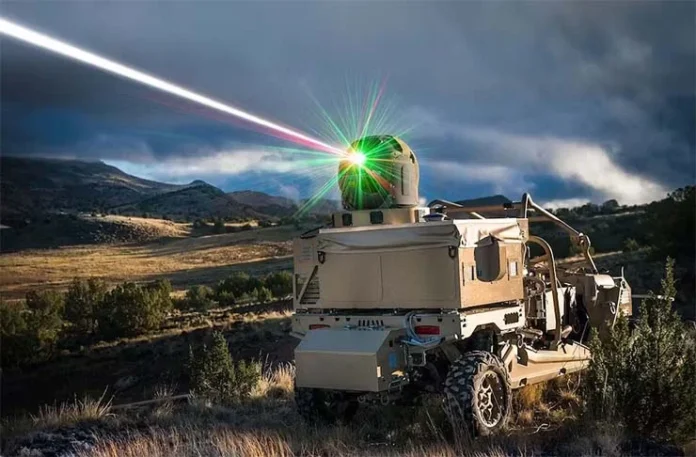There are two main types of Laser Weapons: Spectrum Beams and Distributed Gain Lasers. Spectrum beams are a mixture of fibre lasers, while distributed gain lasers use a series of slabs to amplify laser beams. Both of these are types of high-energy weaponry, which can also include electromagnetic weapons. High-energy weaponry is effective when used non-lethally against individuals.
Overview
- Spectrum beams: These are a mixture of fibre lasers that are similar to those used in fibre communications. They are powerful and precise and can be used to target specific objects with great accuracy
- Distributed gain lasers: These lasers use a series of slabs to amplify laser beams. They were initially created for industrial cutting and welding, but can also be used as weapons
- High-energy weaponry: This is a general category that includes laser weapons and electromagnetic weapons. Electromagnetic weapons use RF and microwave sources as weapons
- Non-lethal: This means that the weapons can disable or injure an opponent without killing them
Electromagnetic weapons (EMW) are a kind of directed-energy weapon that uses high-power electromagnetic radiation to damage or disable enemy targets. EMWs are produced by a magnetic field to accelerate electrons, which then collide with a metal surface to produce microwaves (this is one type of method).
EMWs are often categorized as either high-power microwave (HPM), or radio frequency (RF) weapons. HPM weapons use short pulses of high-power microwave radiation to damage electronic systems. RF weapons use a continuous beam of radio waves that can be used to disrupt electronic systems, heat up materials, or even cause physical injury.
High-energy weaponry is a broad term that encompasses a variety of weapons using high-power energy beams to damage or destroy targets. These weapons include laser guns, particle beams and sound-based weapons.
Laser guns are the most well-known type of high-energy weapon. They use a beam of light to heat up or vaporize targets. Particle beams use beams of subatomic particles, such as electrons or protons, to damage targets. Sound-based weapons use high-power sound waves to damage or disrupt targets.
How Laser Weapons Work
Spectrally Beam Combined (SBC) fibre lasers are a type of laser that is compact, powerful and incredibly accurate. They are made up of multiple fibre lasers combined to create a single, high-power beam. SBC lasers can be powered by batteries, generators, or other existing power sources, making them portable and versatile. Such weapons combine multiple laser beams into a single beam. SBC weapons use beam-control optics and software algorithms to achieve this.
Exposition
Beam-control optics are optical components that are used to control the shape and direction of a laser beam. Software algorithms are computer programs used to control the beam-control optics and ensure that the combined beam is of high quality.
Kilowatt fibre lasers are lasers that can produce a power output of up to 1,000 watts. SBC weapons typically use multiple kilowatt fibre lasers to create a single beam with a power output of several kilowatts or even megawatts.
The combined beam from an SBC weapon is a single, high-quality beam. This means that the beam has a uniform shape and intensity and that it is free of distortions. This makes the beam very precise and allows it to be used to target specific objects with great accuracy.
A laser beam’s energy can be altered to account for atmospheric distortions as it passes through windows, lenses and even mirrors to reach its destination. This is done by using a technique called adaptive optics. Adaptive optics uses a series of sensors to measure the distortions in the atmosphere and then uses a computer to control the shape of the laser beam to compensate for those distortions.
This allows the laser beam to maintain its focus and intensity as it travels through the atmosphere, even over long distances. This is important for laser weapons, because it allows the beam to be accurately targeted at a distant object.
The beam from a laser weapon is capable of destroying a rubber boat, a truck engine and bringing down a drone. This is because the beam can deliver a large amount of energy to a small area. The energy from the beam can cause the target to heat up rapidly, which can cause it to melt, burn, or explode. The beam from a laser weapon is also capable of penetrating windows and other transparent materials. This is because the beam is made up of light, which can pass through transparent materials.
Overall, the beam from a laser weapon is a very powerful and precise weapon. It is capable of destroying a variety of targets and is not affected by gravity or wind. The beam travels in a straight line until it hits its target. This makes laser weapons a potentially very effective weapon for defence and law-enforcement applications.
Understanding Fibre Communication
Fibre communication transmits information through optical fibre in pulses of visible or infrared light. The light is a kind of carrier wave that is adapted to carrying information. Fibre is the preferred choice over electrical cabling when long distances, high bandwidth, or resistance to electromagnetic interference is required. This kind of communication can transmit voice, video and telemetry across long distances, or through local area networks (LANs).
Optical Fibre is a medium that carries light signal from the transmitter to the receiver. Optical fibres are made of glass or plastic and are very thin, typically only a few micrometers in diameter.
Areas of Application:
- Medical imaging: Fibre optic cables are used to transmit images from medical imaging devices, such as endoscopes and CAT scanners
- Computer networks: Fibre optic cables are used to connect computers in LANs and wide area networks (WANs)
- Industrial automation: Fibre optic cables are used to transmit control signals in industrial automation systems
Fibre Laser Simplified
A fibre laser is a type of laser that uses an optical fibre as its gain medium. The gain medium is a material that can amplify light when it is excited by energy. In a fibre laser, the energy is provided by a laser diode, which is a semiconductor device that emits light when it is current-driven.
Fibre lasers have several advantages over other types of lasers. They are typically more efficient, meaning they can produce more laser power with less energy input. They are also more compact, because they do not require a large optical cavity. Additionally, fibre lasers are more stable, meaning they are less likely to lase in an uncontrolled manner
The optical fibre in a fibre laser is typically made of silica glass, which is a transparent material that can transmit light very efficiently. The fibre is doped with a rare-earth element, such as erbium, ytterbium, or neodymium. These elements have the property of absorbing light at one wavelength and emitting light at a different wavelength.
When the laser diode in a fibre laser is current-driven, it emits light at a wavelength that is absorbed by the rare-earth ions in the fibre. The rare-earth ions then emit light at a different wavelength, which is the output wavelength of the laser.
Fibre lasers have several advantages over other types of lasers. They are typically more efficient, meaning they can produce more laser power with less energy input. They are also more compact, because they do not require a large optical cavity. Additionally, fibre lasers are more stable, meaning they are less likely to lase in an uncontrolled manner.
Fibre lasers are used in a variety of applications, including industrial cutting and welding, laser surgery, and laser communication. They are also being investigated for use in military applications, such as laser weapons.
–The author of this article is a Defence, Aerospace & Political analyst based in Bengaluru. The views expressed are of the author and do not necessarily reflect the views of Raksha Anirveda
-The author is a Defence, Aerospace & Political Analyst based in Bengaluru. He is also Director of ADD Engineering Components, India, Pvt. Ltd, a subsidiary of ADD Engineering GmbH, Germany. You can reach him at: girishlinganna@gmail.com. The views expressed are personal and do not necessarily carry the views of Raksha Anirveda






